Whale Watching Big Island | Your Complete Guide
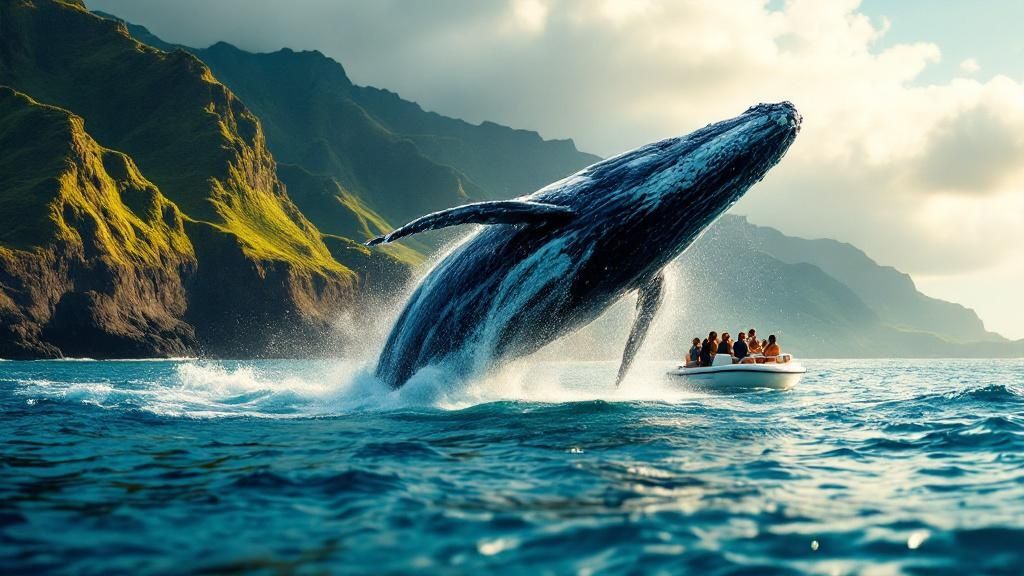
Imagine this: the brilliant turquoise water off the Kona coast suddenly explodes as a forty-ton humpback whale throws its entire body into the air. That's the kind of magic you can expect from whale watching on the Big Island, an absolutely unforgettable experience waiting for you from November through April. This guide is your personal key to seeing it all for yourself.
Welcome to Your Ultimate Big Island Whale Watching Adventure
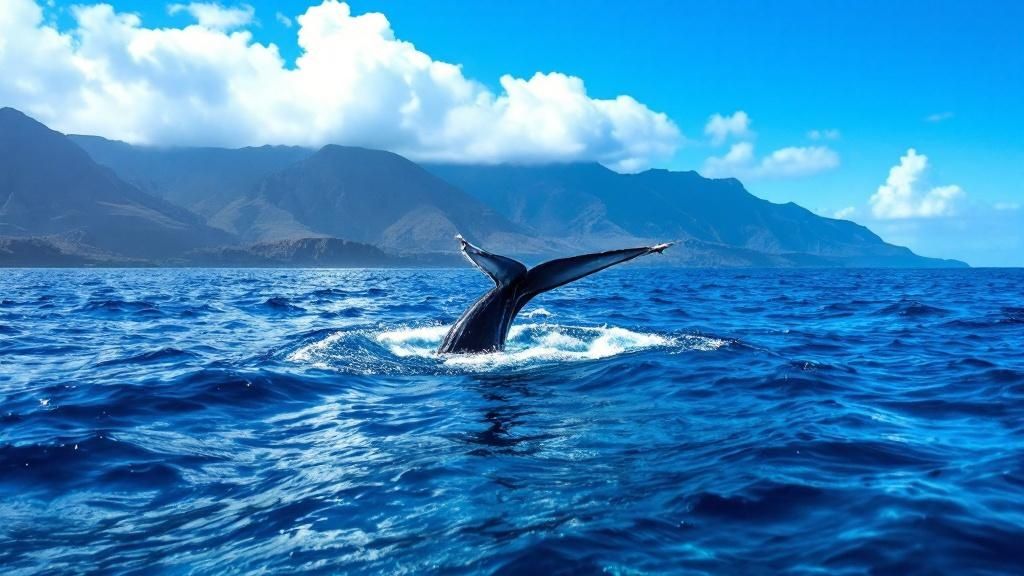
Every single winter, the warm, sheltered waters around Hawaii's Big Island become the main stage for one of nature's greatest shows. Thousands of North Pacific humpback whales make an epic 3,000-mile trip from their chilly feeding grounds in Alaska all the way to this tropical paradise. They come here for the most important reasons of all: to breed, give birth, and raise their newborn calves in a safe haven, far from predators.
This guide is your insider's look at everything you need to pull off a successful adventure. We'll get into the best times to visit for peak action, the prime spots for whale spotting from both sea and shore, and how to pick the perfect tour for you.
To get your journey started with a proven expert, you can’t go wrong with Kona Snorkel Trips. They're the top-rated and most-reviewed snorkel company in all of Hawaii, perfectly set up to lead you on any aquatic adventure, whether you're looking for whales, dolphins, or stunning coral reefs.
Their amazing reputation is built on countless five-star trips, as you can see for yourself above. Now, let's dive into what makes this seasonal migration so special and how you can be a part of it.
Why Choose the Big Island for Whale Watching
While you can technically watch whales from several Hawaiian islands, the Big Island offers a unique and often less crowded experience. The calm, deep waters off the Kona and Kohala coasts are especially appealing to mother whales and their young calves.
This unique underwater landscape creates a natural nursery, which seriously bumps up your chances of seeing those tender moments between mom and baby, not to mention all their playful antics. The island's rugged coastline also gives you tons of amazing vantage points for land-based viewing, so you have great options even if a boat tour isn't your thing.
The Big Island's western coast is a premier destination for whale watching because its leeward side is shielded from strong trade winds, resulting in calmer sea conditions ideal for spotting and observing these magnificent creatures.
Planning your trip is about more than just buying a ticket. It's about getting in sync with the rhythm of the ocean and the life cycle of these gentle giants. With the right know-how, your whale watching trip can go from a simple sightseeing tour to a profound, personal connection with the marine world.
The Epic Journey of Hawaii's Humpback Whales
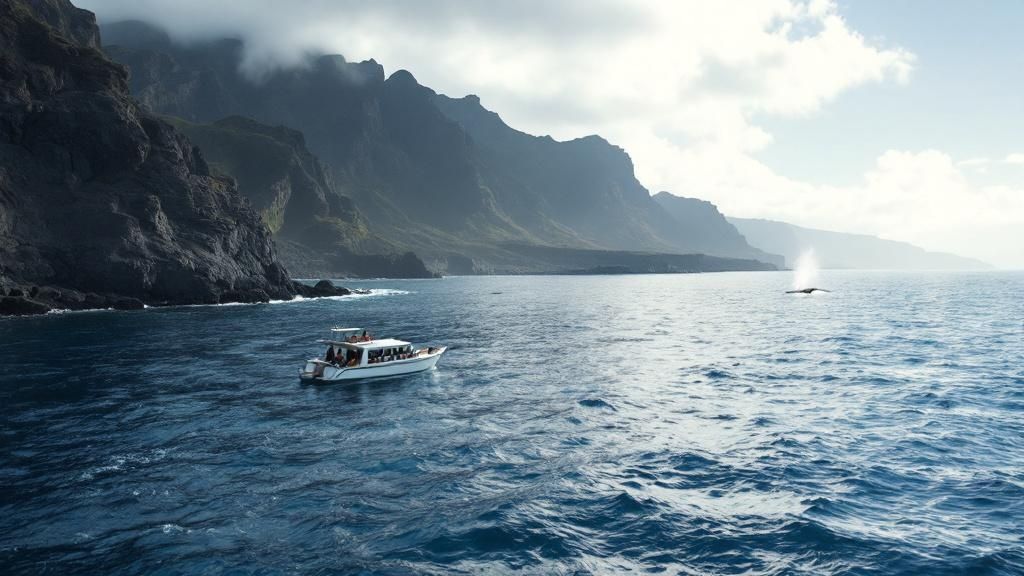
To really get why seeing a humpback off the Big Island is so special, you have to understand their unbelievable story. The whales you see here are finishing up what might be the planet’s most incredible road trip—an annual migration covering 3,000 miles from the icy, food-filled waters of Alaska.
This isn't just a casual vacation for them. It’s a core part of their life, driven by instincts as old as the ocean itself. While the cold Alaskan seas are a perfect all-you-can-eat buffet, they're a dangerous place for a newborn calf. So, every single winter, these gentle giants make the long haul to Hawaii's cozy, protected ocean nursery for one reason.
Hawaii's warm, shallow waters are the perfect safe haven for humpbacks to breed, give birth, and nurse their young. Without the threat of predators like orcas that stalk the colder regions, mothers can focus completely on teaching their calves the survival skills they'll need for a lifetime. Knowing this transforms your whale watching tour from just sightseeing into a powerful connection with a timeless natural cycle.
A Legendary Migration
That journey from Alaska? It's a true marvel of endurance. Humpbacks travel for six to eight weeks straight, cruising at a steady three to five miles per hour. And get this—during the entire migration and their whole stay in Hawaii, they barely eat a thing. They're living almost entirely off the fat reserves they packed on during their summer feeding frenzy up north.
This massive fast highlights just how important their Hawaiian mission is. It's why the calm, sheltered waters off the Big Island's Kona and Kohala coasts are so critical. These spots are aquatic cradles where the next generation of humpback whales gets its start. You can dive deeper into this amazing phenomenon in our complete guide to whale watching on the Big Island.
From Near Extinction to a Conservation Success Story
The fact that we see so many whales today is a story of a truly remarkable comeback. It wasn't that long ago, just a few decades, that the North Pacific humpback whale was teetering on the edge of extinction because of commercial whaling. Their return is one of the greatest conservation success stories of our time.
The protected status of these marine mammals has allowed their populations to rebound significantly, making every sighting a celebration of successful environmental stewardship and a reminder of our responsibility to protect these magnificent creatures.
Today, the humpback population in the Pacific is estimated at around 26,000 individuals—a huge recovery from when they were declared endangered in the 1960s. A key player in this success is the Hawaiian Humpback Whale National Marine Sanctuary, which was set up in the early 1990s to protect these vital habitats around the Big Island and other Hawaiian islands.
Dedicated volunteers even help track the recovery through annual Sanctuary Ocean Counts. For example, during a coordinated count on February 22, 2025, they spotted 1,947 whales across the main islands. A whopping 263 of those were seen around the Big Island alone, proving just how vital this place is for them. You can find more details in the report on this season's whale count.
This inspiring recovery ensures that the epic journey of the humpback whales continues, allowing us and future generations to witness their awe-inspiring beauty in Hawaiian waters.
Pinpointing the Best Time for Whale Watching
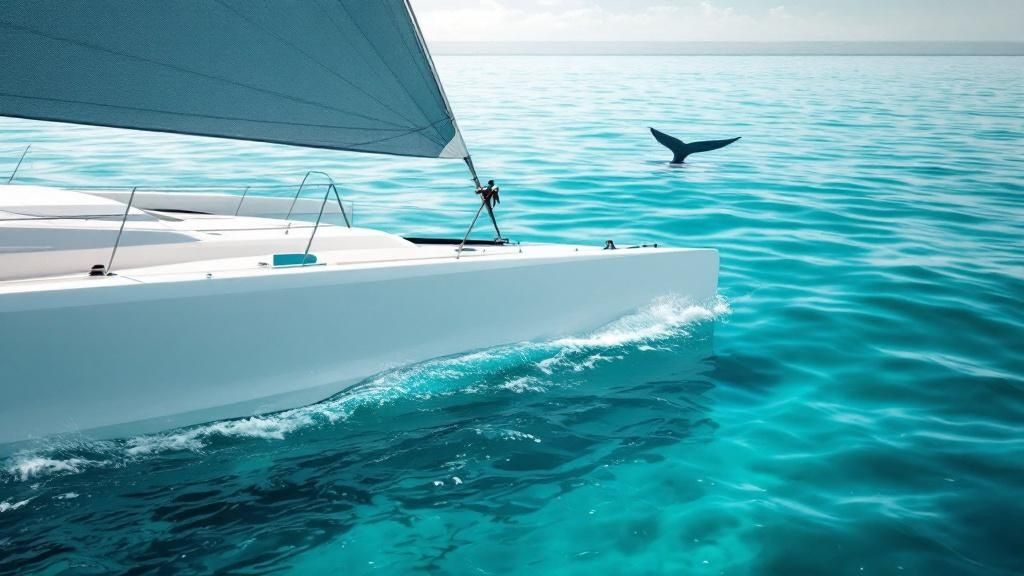
When it comes to having an absolutely mind-blowing whale watching experience, timing is everything. It’s kind of like planning to see the perfect sunrise; you don't just show up on the right day, you have to be there at the exact right moment. For whale watching on the Big Island, that magic window is open from November through April. This is when thousands of humpback whales make Hawaiian waters their winter home.
While you can spot whales throughout the season, the action really ramps up during the peak months. If your goal is to see the highest number of whales and the most incredible surface activity, you’ll want to plan your trip for January and February.
During these two months, the whale population density is at its absolute peak. Think of it as a numbers game—and in January and February, the odds are stacked in your favor. More whales in the water means more opportunities to witness those jaw-dropping behaviors like full-body breaches, powerful tail slaps, and friendly pectoral fin waves.
Big Island Whale Watching Season At A Glance
To help you visualize the flow of the season, here’s a quick breakdown of what to expect month by month. This should give you a clearer picture when planning your adventure.
| Month | Sighting Probability | Typical Activity | Notes |
|---|---|---|---|
| November | Low to Moderate | Early arrivals, scouting the area. Sightings are possible but less frequent. | The first pioneers of the season begin to appear. |
| December | Moderate to High | Population growing, more consistent sightings. Pods are forming. | A great time to visit before the peak holiday crowds. |
| January | Peak | Highest density of whales. Breaching, tail slapping, and mating behaviors are common. | The absolute best month for sheer numbers. |
| February | Peak | Very high density. Mothers with newborn calves start to appear more frequently. | Alongside January, this is prime time for whale action. |
| March | High to Moderate | Still plenty of whales, but numbers begin to decline towards the end of the month. | Great activity continues, especially with cow-calf pairs. |
| April | Moderate to Low | Last of the whales, primarily mothers and calves, preparing for their journey north. | Your last chance to see them before they depart for Alaska. |
Ultimately, planning for January or February gives you the absolute best shot at seeing the most whales and the most spectacular behaviors.
The Early Bird Gets the Whale
Beyond just picking the right month, there’s another trick that seasoned locals and tour operators swear by: the time of day. Heading out first thing in the morning is a strategic move that can seriously upgrade your experience.
The ocean is typically at its calmest in the morning hours, before the afternoon trade winds start to kick up. A glassy, smooth surface makes it so much easier to spot the tell-tale signs of a whale, like a distant misty spout hanging in the air.
Plus, that soft, golden morning light creates the perfect conditions for taking stunning, glare-free photos of your encounters. You can learn more about planning your trip around the Big Island whale watching season.
Pro Tip: Planning your whale watch for an early morning in January or February is the ultimate recipe for success. You're aligning peak whale numbers with the best possible viewing conditions, which dramatically increases your odds of an unforgettable encounter.
Where to See Whales by Land and Sea
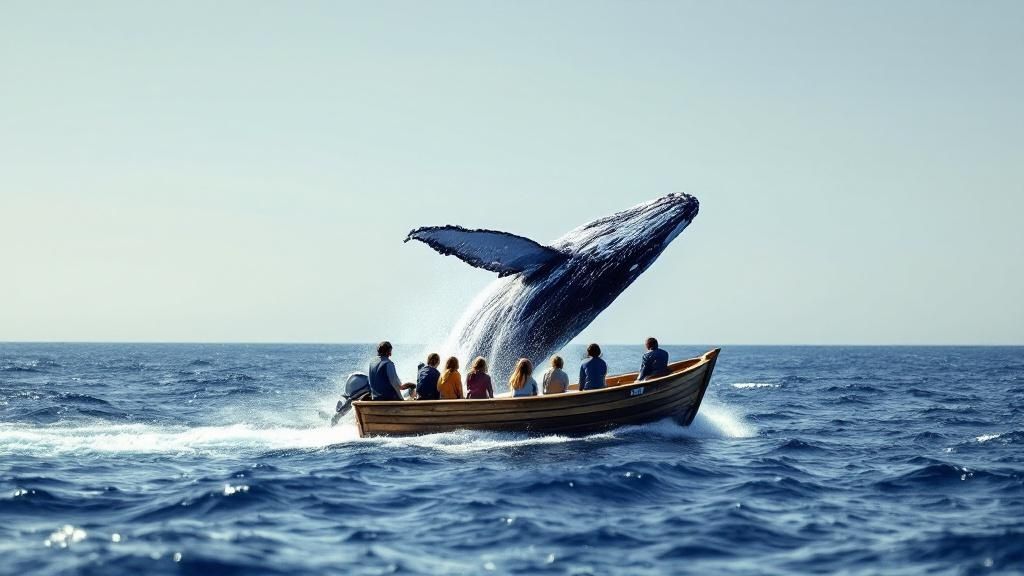
Alright, you know when to come for the show. Now for the million-dollar question: where do you go?
When it comes to whale watching on the Big Island, you’ve got incredible options, whether you're keen on a boat tour or prefer to keep your feet planted on solid ground. Both give you completely different perspectives, and honestly, both can lead to some truly unforgettable moments.
The Undisputed Champion: The Kohala Coast
If you’re heading out on the water, there’s one area that’s simply in a league of its own: the Kohala Coast. This stunning stretch along the island's northwestern side is a certified magnet for humpback whales, especially mothers with their brand-new calves.
The reason is beautifully simple. The Kohala Coast sits on the island's leeward side, shielding it from the powerful trade winds. This creates exceptionally calm, protected waters—basically the perfect ocean nursery for whales to rest, nurse, and teach their young how to be whales without fighting rough seas.
Booking a tour that sticks to the Kohala Coast dramatically stacks the odds in your favor for consistent, meaningful sightings. The tranquil conditions don't just attract more whales; they make the entire experience for you, the whale watcher, so much more comfortable and pleasant.
And this isn't just local folklore. The numbers back it up year after year. Coordinated annual whale counts consistently prove the Kohala Coast's heavyweight status for humpback activity.
In the most recent counts from February 22, 2025, volunteers tallied up an amazing 263 whale sightings near the Big Island. The highest concentrations? You guessed it, right along this very coastline. You can dig into more of the fascinating details from these annual shoreline counts.
This data just confirms what local boat captains have known in their gut for decades: for the absolute best whale watching Big Island experience by sea, you head for the Kohala Coast. End of story.
Top Land-Based Whale Watching Hotspots
Maybe a boat tour isn't on your agenda. No problem at all. The Big Island's dramatic coastline is dotted with elevated lookouts that serve as incredible natural amphitheaters for whale watching. All you really need is a decent pair of binoculars, a healthy dose of patience, and a comfy spot at one of these prime locations.
Here are the best places to catch the action from shore:
-
Pu'ukoholā Heiau National Historic Site: The name literally means "hill of the whale" in Hawaiian. That pretty much tells you everything you need to know. This historic site offers sweeping, elevated views over the ocean, making it an ideal perch to scan for spouts and breaches. The palpable history of the place just adds another layer to the experience.
-
Lapakahi State Historical Park: A bit further north up the coast, this park has some excellent vantage points from its rugged, sea-cliff trails. Being up so high gives you a massive perspective of the ocean, letting you spot whales that might be miles offshore. Just a heads up, it's a hot and dry area, so be sure to pack plenty of water and sun protection.
-
Scenic Highway Pull-Offs: Never, ever underestimate the power of a simple roadside stop. The highways winding along the Kohala and North Kona coasts have tons of scenic pull-offs. These spots are often perched high above the water and give you fantastic, unobstructed views. Just keep your eyes peeled as you drive and be ready to pull over safely when a promising vista appears.
No matter which spot you choose, the real key is patience. Find a comfortable place to sit, scan the horizon methodically, and just listen. Sometimes you'll hear the thunderous whoosh of a breach before you ever see it. With a little luck, you'll be rewarded with a spectacular show from the best seats on the island—and it won't cost you a dime.
Picking the right tour is probably the biggest decision you'll make for your whole whale watching trip. Honestly, the boat you're on and the crew you're with can completely change the game, turning a good day into an absolutely unforgettable one. It really comes down to what you're looking for: comfort, adventure, a small group vibe, or the best possible view.
The first thing to figure out is what kind of boat you want to be on. Each one offers a totally different experience, and there's no "best" choice—just what's best for you.
Catamarans and Larger Vessels
If you're bringing the family, are new to whale watching, or just get a little queasy on the water, a big, stable catamaran is your best bet. Their double-hull design keeps things steady and smooth, which is a lifesaver if the ocean decides to get a little choppy.
These bigger boats usually come loaded with creature comforts that make the trip that much more enjoyable. You can pretty much count on:
- Onboard Restrooms: A huge plus, especially on a tour that lasts a few hours.
- Shade: The Hawaiian sun is no joke, so having a place to escape it is key.
- Snacks and Drinks: Many have a little galley, which is perfect for keeping everyone, especially kids, happy.
- Hydrophones: This is one of the coolest features. They drop a microphone into the water so you can hear the incredible, haunting songs of the male humpbacks in real-time. It's magical.
Plus, the higher viewing decks on these boats give you a fantastic vantage point for spotting those tell-tale spouts way out on the horizon.
Zodiacs and Smaller Rafts
Now, if you're craving something a bit more adventurous and up-close, you can't beat a Zodiac-style raft. These things are fast, nimble, and sit low in the water, putting you practically eye-level with the whales. It’s a perspective that really makes you feel the sheer scale of these animals.
Because they're so maneuverable, the captain can often get you to a sighting much quicker. The groups are also way smaller—usually under 25 people—which makes for a more intimate, less crowded feel. Just be prepared: it's a bumpier, wetter ride and you won't find many amenities onboard. This is definitely the choice for the thrill-seeker.
Think of it like choosing your seat at a concert. Do you want the comfortable, panoramic view from the balcony (the catamaran)? Or do you want to be in the front row, feeling the energy and spray up close (the Zodiac)? Both are incredible, just different vibes.
Key Questions to Ask Before You Book
Once you've got a boat type in mind, it's time to check out the actual tour companies. Asking just a few smart questions can help you find a great crew that’s responsible, reputable, and will deliver the experience you're hoping for.
Before you pull out your credit card, make sure you know the answers to these:
- What’s your usual group size? This tells you how much elbow room you'll have and how easy it will be to get a spot at the rail for a clear view.
- How long is the tour? They typically run from two to four hours. A longer trip gives you more time out on the water, which means more chances to find whales and watch them for a while.
- Is there a naturalist on board? Having an expert along to explain what you're seeing—the different behaviors, the science behind the songs—adds a whole other layer to the experience. It makes it so much more meaningful.
- How do you practice responsible whale watching? This is a big one. You want a company that takes the rules seriously. They should be committed to staying 100 yards away from the whales and participating in local conservation. Choosing a responsible operator helps protect these amazing animals for years to come.
Getting Ready for Your Day on the Water
A little prep work can be the difference between a good whale watching tour and an absolutely incredible one. When you know what to bring and what to look for, you can stop worrying about the small stuff and just soak in the experience. Trust me, you'll want to be fully present for this.
Your day will almost always kick off with a friendly safety briefing from the captain and crew. They’ll show you the ropes—literally—pointing out the boat’s layout, safety gear, and the general rules of being out on the ocean. This is often when the onboard naturalist chimes in with some mind-blowing facts about the humpbacks, getting everyone amped up for what's to come.
Then, it's time to cast off. The ride out of the harbor is an experience in itself, with gorgeous views of the Kona or Kohala coast. As you cruise, the crew’s expert eyes will be glued to the horizon, searching for that first tell-tale sign: the "blow," a misty spray of water exhaled by the whales. The second someone yells, "Whale!" the energy on the boat is pure electricity.
What to Look for and How to Spot Them
Once a whale or pod is in sight, the real show begins. Your captain will keep a respectful distance, as required by law—a minimum of 100 yards. But here’s the cool part: humpbacks are curious creatures, and often, they'll decide to come check you out.
To really appreciate what you're seeing, it helps to know what to look for. These aren't just random splashes; they're all forms of communication.
- Breach: This is the big one—the iconic, jaw-dropping leap where a whale launches its massive body almost completely out of the water. Scientists have a few theories: it could be a way to talk to other whales, shake off pesky parasites, or maybe, they’re just doing it for the sheer joy of it.
- Tail Slap (Lobtailing): You’ll see a whale lift its huge tail fluke high into the air and slam it down on the water's surface. It creates a thunderous boom that travels for miles underwater, likely serving as a warning or a long-distance call to other whales.
- Spy-hopping: Ever seen a whale pop its head straight up out of the water like a submarine periscope? That's spy-hopping. It's their way of getting a good look at what's going on above the waves—including your boat.
- Pectoral Fin Slap: A whale will often roll onto its side and just start slapping its long pectoral fin on the water over and over again. Like a tail slap, it’s another way they make noise to communicate.
When you can identify these behaviors, the whole experience changes. You go from just watching a nature documentary to feeling like you're interpreting a complex conversation happening right in front of you.
Your Essential Packing List
Being comfortable on the water is key. The last thing you want is to be distracted by a sunburn or a chill when a 40-ton whale is putting on a show right off the bow.
Here's a no-fluff checklist of what you should absolutely bring:
- Reef-Safe Sunscreen: The Hawaiian sun doesn't mess around, and it's even stronger reflecting off the water. Go for a mineral-based sunscreen (with zinc oxide or titanium dioxide) to protect both your skin and our fragile coral reefs.
- Polarized Sunglasses: This is a non-negotiable. They cut the glare on the water's surface, making it so much easier to spot whales and see what's happening just below.
- A Light Jacket or Windbreaker: It can be a beautiful, warm day on land, but once you get moving on the water, the wind can make it surprisingly chilly. A light layer is all you need.
- Camera with a Zoom Lens: Your phone will get the job done, but if you have a camera with a decent zoom, bring it. You’ll be able to capture stunning detail without disturbing the whales.
- Binoculars: A must-have, whether you're watching from shore or on a boat. They bring distant spouts and breaches right to you.
- Motion Sickness Medication: If you even think you might get seasick, take your preferred remedy before you get on the boat. It works much better as a preventative.
With this gear in your bag, you’ll be set. You can step on board feeling prepared, relaxed, and ready for a day you’ll never forget.
Answering Your Whale Watching Questions
Let's wrap up with a few of the questions I hear all the time from folks getting ready for their first whale watching trip. Knowing the answers beforehand helps you step onto the boat feeling relaxed and ready for an incredible day on the water.
Is a Whale Sighting Guaranteed on a Tour?
This is always the big one, and for good reason! While the best tour operators see whales on 95% to 99% of their trips during the peak months of January and February, they can't legally or ethically promise you'll see one. These are wild animals, after all, living life on their own terms in a massive ocean.
That said, the sheer number of whales in the water during peak season makes your chances incredibly high. A good, experienced captain knows exactly where the whales tend to hang out, which gives you the absolute best shot at a magical encounter.
How Close Can the Boats Actually Get?
To keep the whales safe and happy, federal law is very strict: all boats have to stay at least 100 yards away from humpback whales. This rule is non-negotiable and it's essential for protecting the whales, especially the new mothers and their calves, from any stress.
But here's where things get really special. That law only applies to the boats, not the whales. Humpbacks are naturally curious creatures, and sometimes, they decide to come check us out. When a whale approaches a stopped boat on its own, it’s called a "mugging," and it’s a completely unforgettable, up-close experience that happens entirely on the whale's terms.
What Else Might We See Out There?
Humpbacks are definitely the stars of the show, but the waters off the Big Island are just buzzing with life. It's almost a given that you'll be greeted by a pod of playful spinner dolphins, who just love to surf the waves at the front of the boat.
You might also catch a glimpse of bottlenose dolphins, and if you're really lucky, maybe even pilot whales or false killer whales. And don't forget to keep an eye on the coastline—you’ll often spot Hawaiian green sea turtles (honu) popping their heads up for a breath of air.
Are Whale Watching Tours a Good Idea for Kids?
Absolutely! A whale watching tour is one of the most awe-inspiring and educational things you can do with your family. Most tour boats, especially the larger, more stable catamarans, are perfectly set up for younger guests. Seeing a 40-ton whale launch its entire body out of the water is a memory a child will hold onto for the rest of their life.
If you're still figuring out the timing for your family vacation, you can get more details on the best months to visit by reading about whale season in Hawaii. Just be sure to double-check with your tour operator about age limits, as some of the smaller, zippier raft-style boats might have them.
